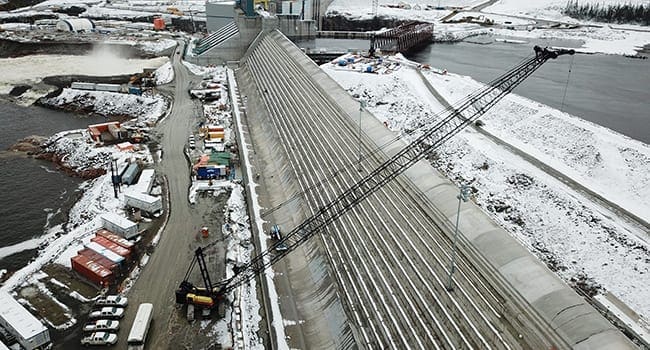 It may be time to pay homage to hydroelectric dams and their role in our quality of life. But that homage may be more of a eulogy than a celebration.
It may be time to pay homage to hydroelectric dams and their role in our quality of life. But that homage may be more of a eulogy than a celebration.
Large and small dams have a glorious history. Rivers turned grist mills that processed farmers’ grain into food, and powered machinery that sawed trees into lumber for building.
Later, these dams generated electricity.
This has been a benefit for hundreds of years. But the end of the lifespan and usefulness of dams has crept up on us over the past generation.
Small dams date back three centuries in the oldest parts of North America. Canadian data is hard to come by but emergency planners in Louisville, Ky., estimate there are 77,000 dams in the American inventory and about 2,000 are unsafe.
In the United States, 20 percent of dams were built in the 18th century. The average age is 40 years. More than 80 percent of dams are made of earth, which likely also means they contain garbage and other unstable matter.
Vulnerable towns and cities are downstream from about 1,500 dams.
This is really old and dangerous infrastructure.
Research is also beginning to show the economic cost of dams, not just the benefit. We lose fish, damn up silt that makes storm surges more dangerous and reduce the value of real estate.
We have similar challenges with small dams in Canada but what has caught the attention of some researchers are the big dams. There are questions about the usefulness of two of the last remaining big dam projects at both ends of our country.
Lawyer Jonathan Drance has spent most of his career in an energy practice based in Vancouver. He’s scrutinizing Site C on the Peace River – about the last megaproject in a province built on megaprojects.
In a telephone interview, he conceded that the “two rivers” policy of former B.C. premier W.A.C. Bennett helped build the modern province. Dams on the Peace and Columbia Rivers powered homes, industry, mining and even the iconic public transit SkyTrain.
But an article Drance co-authored with Glenn Cameron and Rachel V. Hutton captures all the current challenges for such a project. It’s always about money and this dam is one of the most capital-intensive power projects in the world. Cost overruns will make sure it stays that way.
Surprisingly, even in an expanding economy with power consumption going up every time someone plugs in a computer or turns on an air conditioner, Site C power may not be needed. Reasons include conservation, alternative energy sources and the very difficult task of predicting demand.
Large projects are costly and controversial. And small projects such as rooftop solar and new ways of storing power offer cheaper alternatives. Drance also notes that the modern approval process adds years and dollars to any project.
Drance and his colleagues flag two other issues and point to similar challenges on the other side of the country. First is what’s variously called path dependency or sunk costs. This favoured approach continues to be followed even it doesn’t work well anymore.
Once a project is partially built, it can cost more to stop building than to keep going. Site C is so expensive that it could affect credit ratings and even put spending for schools, hospitals, highways and bridges in jeopardy.
Worse, the article points to the other mega-dam under construction – Muskrat Falls in Newfoundland and Labrador. This project is so big and costly that it threatens the solvency of Nalcor Energy, a provincial Crown corporation, and even of the province itself.
But that project is really for Newfoundland and Labrador researchers to tackle. And RMIT University’s Linh Vu has done just that. She and her colleague Dr. Roberto Martinez-Espineira have another way of describing sunk costs and path dependency. She calls it the “Hiding Hand” principal. This might also be called rose coloured glasses because she says “project planners display optimism bias in ‘manipulating’ costs and benefits” to get a project built.
She cites more than 2,000 large projects and says almost 80 percent feature both unexpected costs and low benefits. She cites another study of large dams built since 1934 and finds that three out of four had cost overruns, and actual costs were 96 percent higher than estimates.
Like Drance, Vu notes the difficulty in forecasting demand. A big problem is that excess electricity can’t be stored, so it’s essentially waste.
Nalcor Energy was overly optimistic about economic growth in the province, demographics and demand. There were also ways to use small projects or alternative energy sources to act as a bridge to 2041 when the arrangement with Hydro-Quebec ends and Churchill Falls power is available to Newfoundland and Labrador.
But there’s more beneath the surface. The reservoir created when a dam is built looks like a perfect spot for recreation – boating, swimming, camping and so on. But these lakes often displace people. And the water becomes contaminated with methyl mercury, which causes health problems.
In the early 1970s, ecologist Barry Commoner coined four laws, including “there is no such thing as a free lunch.” Putting a water wheel or a turbine in flowing water seemed to be a free lunch for a few hundred years, but not so much anymore.
Also in the early 1970s, economist E.F. Schumacher wrote a book entitled Small is Beautiful.
Fifty years later, it seems both Commoner and Schumacher were right.
Dr. Allan Bonner, MSc, DBA, is a crisis manager based in Toronto.
Allan is a Troy Media contributor. Why aren’t you?
The views, opinions and positions expressed by columnists and contributors are the author’s alone. They do not inherently or expressly reflect the views, opinions and/or positions of our publication.


